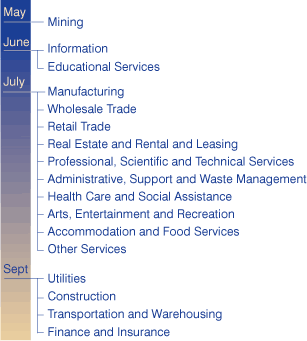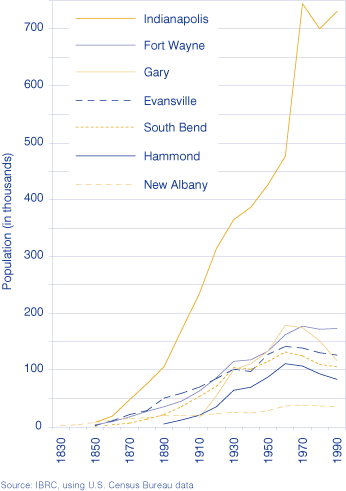Inside the Data Center
The Economic Census
The 2002 Economic Census began collecting data on the nation’s businesses in late 2002, and it is in the process of being released by the Census Bureau. Currently, state level data is being released (see Table 1) and is available through the American FactFinder website (https://data.census.gov).
Table 1: Release Dates for Indiana Sector Data

To help users better understand and gain access to the 2002 Economic Census and how it relates to past economic censuses, the Census Bureau is offering two hands-on seminars to be held in Indianapolis at the Indiana State Library on September 23rd at 9:00 a.m. and 1:30 p.m. Both seminars are free to the public and each will last three hours.
Racial and Ethnic Composition Since 1790
Since the first census in 1790, when U.S. marshals counted 3.9 million residents, the decennial census has collected data on the nation’s population, including data on racial composition. For the first time, the U.S. Census Bureau has released a historical summary by city, titled Historical Census Statistics on Population Totals by Race, 1790 to 1990, and by Hispanic Origin, 1970 to 1990, for Large Cities and Other Urban Places in the United States. It is available online at www.census.gov/content/dam/Census/library/working-papers/2002/demo/POP-twps0056.pdf.
This working paper illustrates how the composition by race and Hispanic origin has changed over the years in 306 cities. Data are provided for 224 places that have had a census population of 100,000 or more at some point from 1790 to 1990, as well as another 82 places that historically were among the largest in their state. As shown in Figure 1, Indiana cities and towns included in the working paper are Evansville, Fort Wayne, Gary, Hammond, Indianapolis, New Albany and South Bend.
Figure 1: Total Population, 1830 to 1990

The racial categories used in the report are those used in the 1990 census. Data from Census 2000 are not included because they are not directly comparable with race data from previous censuses.
Handbook for State and Local Officials
The Data Center has received a few phone calls from concerned citizens about the legitimacy of a new survey they have received in the mail. A local police department also called after an individual in the community contacted them about someone coming to their door with a laptop computer claiming to be from the Census Bureau. The fact is, starting in January of 2005, the U.S. Census Bureau started mailing the American Community Survey to 300,000 addresses every month in every county of the United States, including every county in Indiana. The Census Bureau has published an informative and helpful document entitled American Community Survey—A Handbook for State and Local Officials. This document, along with a sample of the survey questionnaire and many other publications, can be found at www.census.gov/acs.
By Frank Wilmot, State Data Center Coordinator
Indiana State Library
